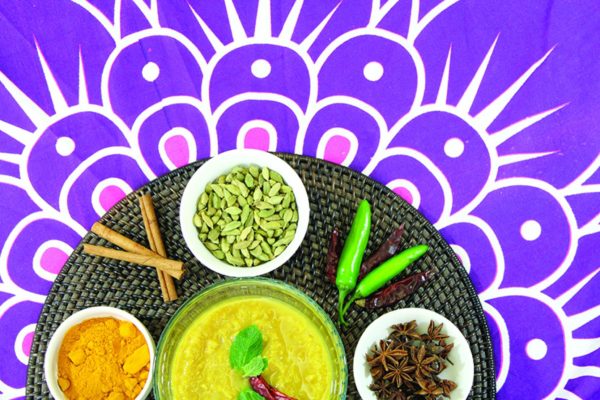
“Indian food is more than Tikka Masala,” says Devika Palaniswamy, president of the Indian Students Association (ISA) at The University of Texas at Austin. Palaniswamy, along with other students in ISA, wanted to show fellow students on campus a range of flavors in Indian cuisine.
The Division of Housing & Food Service agreed to help them do that.
Claudia Ashlock, associate director of residential dining, says she was thrilled when Palaniswamy contacted her. Together, Dining Services and ISA developed a meal showcasing cuisines from across India. The themed dinner, called “The Spice of Life,” had a menu featuring food from northern and southern India.
The meal was served to more than 1,700 students last Thursday, February 2, 2017, at the two main dining halls on campus – Jester and Kinsolving. It was the first of two themed meals that Dining Services hosts each semester at its all-you-care-to-eat dining halls.

“We want our theme meals to be educational,” said Ashlock. “We want the students to learn something new about the world through the food.”
In addition to food, the students organized dances, games and henna art for the guests.
Palaniswamy says ISA and Dining Services wanted to highlight the fresh, home-cooked side of Indian food. To do that, the dining halls used some of her mother’s recipes.

“These peanut and tomato chutney recipes are what we use at home and are traditional south Indian recipes,” she says. Palaniswamy is from Flower Mound, Texas, but her parents are from Tamil Nadu, a state on the southern tip of India.
Chutneys are one of the distinctive elements of southern Indian food. Tamil chutneys usually contain coconut, peanuts, lentils, tamarind, fenugreek seeds and cilantro. Ranging in texture from salsa to relish, these condiments bring sweet, spicy and salty accents to a meal. They not only add delicious taste, but are thought to improve digestion.
Missed the dinner but want to try the food? Here are some of Palaniswamy’s family recipes.
Tomato Chutney:

1 chopped medium yellow onion
4 chopped Roma tomatoes
2 dried red Indian chilies
4 green Indian chilies
1/8 of a fresh coconut (or about 1 cup if frozen and shredded)
1/4 of a bunch of cilantro (chopped)
1 teaspoon of salt (or more/less to taste)
1 teaspoon of chana dal (available at Indian store)
1 teaspoon of toor dal (available at Indian store)
1/4 teaspoon of cumin seeds (available at Indian store)
1/4 teaspoon of black mustard seeds (available at Indian store)
4 teaspoons of any oil
Heat a pot on medium. Pour the oil and add the cumin seeds, mustard seeds, chana dal and toor dal. Fry until brown (but not burned). Next, add the green chilies, red chilies and the chopped onion pieces and fry on both sides. Then add the chopped tomato pieces. Stir and let it cook. Add the desired amount of salt. Once all have been cooked thoroughly, dump the contents into a blender to grind. Add the coconut and cilantro to the blender as well and begin grinding. Grind/blend just enough so it is at the consistency of a normal chutney. If it is too thick, add water in small quantities until the desired consistency is reached.
Peanut Chutney:

Whole indian red chili, cardamom pods and star anise. Photo by Madeleine Klein.
1 cup dry, roasted peanuts
3 dried small Indian red chilies
1/4 teaspoon of salt (or more to taste)
1 grape-size piece of tamarind (or about 1/2 teaspoon of tamarind paste)
1/2 cup of water
Grind peanuts, chilies, salt and tamarind together in a blender. Then, add water and grind again. Grind/blend just enough so it is at the consistency of a relish.
For extra flavor, try adding a chili oil on top of the chutney. Fry the following spices in oil to bring out the flavor, and pour on top of the finished chutney.
For 1 cup of chutney:
1-2 teaspoons oil
1/2 teaspoon of mustard seeds
1/4 teaspoon of cumin seeds
1/2 teaspoon of urad dal
1/2 teaspoon of channa dal
10 curry leaves
1 dried red chilly
Fry the spices in oil until they become slightly brown, then pour it on top of the chutney and mix.
For more UT Austin student life stories, follow us on Snapchat @utaustintx





